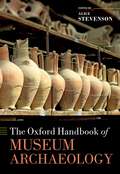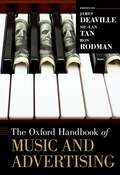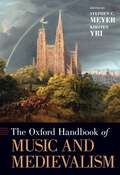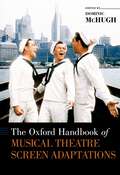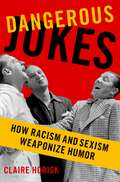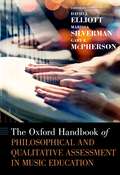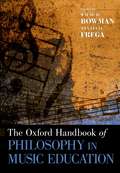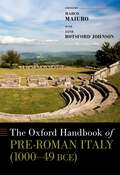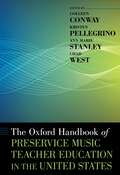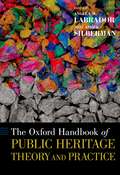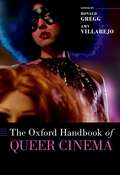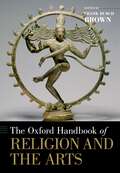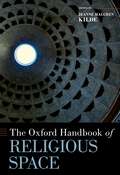- Table View
- List View
The Oxford Handbook of Museum Archaeology (Oxford Handbooks)
by Alice StevensonThis Handbook provides a transnational reference point for critical engagements with the legacies of, and futures for, global archaeological collections. It challenges the common misconception that museum archaeology is simply a set of procedures for managing and exhibiting assemblages. Instead, this volume advances museum archaeology as an area of reflexive research and practice addressing the critical issues of what gets prioritized by and researched in museums, by whom, how, and why. Through twenty-eight chapters, authors problematize and suggest new ways of thinking about historic, contemporary, and future relationships between archaeological fieldwork and museums, as well as the array of institutional and cultural paradigms through which archaeological enquiries are mediated. Case studies embrace not just archaeological finds, but also archival field notes, photographic media, archaeological samples, and replicas. Throughout, museum activities are put into dialogue with other aspects of archaeological practice, with the aim of situating museum work within a more holistic archaeology that does not privilege excavation or field survey above other aspects of disciplinary engagement. These concerns will be grounded in the realities of museums internationally, including Latin America, Africa, Asia, Oceania, North America, and Europe. In so doing, the common heritage sector refrain 'best practice' is not assumed to solely emanate from developed countries or European philosophies, but instead is considered as emerging from and accommodated within local concerns and diverse museum cultures.
The Oxford Handbook of Museum Archaeology (Oxford Handbooks)
This Handbook provides a transnational reference point for critical engagements with the legacies of, and futures for, global archaeological collections. It challenges the common misconception that museum archaeology is simply a set of procedures for managing and exhibiting assemblages. Instead, this volume advances museum archaeology as an area of reflexive research and practice addressing the critical issues of what gets prioritized by and researched in museums, by whom, how, and why. Through twenty-eight chapters, authors problematize and suggest new ways of thinking about historic, contemporary, and future relationships between archaeological fieldwork and museums, as well as the array of institutional and cultural paradigms through which archaeological enquiries are mediated. Case studies embrace not just archaeological finds, but also archival field notes, photographic media, archaeological samples, and replicas. Throughout, museum activities are put into dialogue with other aspects of archaeological practice, with the aim of situating museum work within a more holistic archaeology that does not privilege excavation or field survey above other aspects of disciplinary engagement. These concerns will be grounded in the realities of museums internationally, including Latin America, Africa, Asia, Oceania, North America, and Europe. In so doing, the common heritage sector refrain 'best practice' is not assumed to solely emanate from developed countries or European philosophies, but instead is considered as emerging from and accommodated within local concerns and diverse museum cultures.
The Oxford Handbook of Music and Advertising (Oxford Handbooks)
by Siu-Lan Tan James Deaville Ron RodmanThe Oxford Handbook of Music and Advertising is an essential guide to the crucial role that music plays in relation to the audio or audiovisual advertising message, from the perspectives of its creation, interpretation, and reception. The book's unique three-part organization reflects this life cycle of an advertisement, from industry inception to mass-mediated text to consumer behaviour. Experts well versed in the practice, analysis, and empirical studies of the commercial message have contributed to the collection's forty-two chapters, which collectively represent the most ambitious and comprehensive attempt to date to address the important intersections of music and advertising. Handbook chapters are self-contained yet share borders with other contributions within a given section and across the major sections of the book, so readers can either study one topic of particular interest or read through to gain an understanding of the broader issues at stake. Within the book's Introduction, each editor has provided an overview of the unifying themes for the section for which they were responsible, with brief summaries of individual contributions at the beginnings of the sections. The lists of recommended readings at the end of chapters are intended to assist readers in finding further literature about the topic. An overview of industry practices by a music insider is provided in the Appendix, giving context for the three parts of the book.
The Oxford Handbook of Music and Advertising (Oxford Handbooks)
The Oxford Handbook of Music and Advertising is an essential guide to the crucial role that music plays in relation to the audio or audiovisual advertising message, from the perspectives of its creation, interpretation, and reception. The book's unique three-part organization reflects this life cycle of an advertisement, from industry inception to mass-mediated text to consumer behaviour. Experts well versed in the practice, analysis, and empirical studies of the commercial message have contributed to the collection's forty-two chapters, which collectively represent the most ambitious and comprehensive attempt to date to address the important intersections of music and advertising. Handbook chapters are self-contained yet share borders with other contributions within a given section and across the major sections of the book, so readers can either study one topic of particular interest or read through to gain an understanding of the broader issues at stake. Within the book's Introduction, each editor has provided an overview of the unifying themes for the section for which they were responsible, with brief summaries of individual contributions at the beginnings of the sections. The lists of recommended readings at the end of chapters are intended to assist readers in finding further literature about the topic. An overview of industry practices by a music insider is provided in the Appendix, giving context for the three parts of the book.
The Oxford Handbook of Music and Medievalism (Oxford Handbooks)
by Stephen C. Meyer Kirsten YriThe Oxford Handbook of Music and Medievalism provides a snapshot of the diverse ways in which medievalism--the retrospective immersion in the images, sounds, narratives, and ideologies of the European Middle Ages--powerfully transforms many of the varied musical traditions of the last two centuries. Thirty-three chapters from an international group of scholars explore topics ranging from the representation of the Middle Ages in nineteenth-century opera to medievalism in contemporary video game music, thereby connecting disparate musical forms across typical musicological boundaries of chronology and geography. While some chapters focus on key medievalist works such as Orff's Carmina Burana or Peter Jackson's Lord of the Rings films, others explore medievalism in the oeuvre of a single composer (e.g. Richard Wagner or Arvo Pärt) or musical group (e.g. Led Zeppelin). The topics of the individual chapters include both well-known works such as John Boorman's film Excalibur and also less familiar examples such as Eduard Lalo's Le Roi d'Ys. The authors of the chapters approach their material from a wide array of disciplinary perspectives, including historical musicology, popular music studies, music theory, and film studies, examining the intersections of medievalism with nationalism, romanticism, ideology, nature, feminism, or spiritualism. Taken together, the contents of the Handbook develop new critical insights that venture outside traditional methodological constraints and provide a capstone and point of departure for future scholarship on music and medievalism.
The Oxford Handbook of Music and Medievalism (Oxford Handbooks)
The Oxford Handbook of Music and Medievalism provides a snapshot of the diverse ways in which medievalism--the retrospective immersion in the images, sounds, narratives, and ideologies of the European Middle Ages--powerfully transforms many of the varied musical traditions of the last two centuries. Thirty-three chapters from an international group of scholars explore topics ranging from the representation of the Middle Ages in nineteenth-century opera to medievalism in contemporary video game music, thereby connecting disparate musical forms across typical musicological boundaries of chronology and geography. While some chapters focus on key medievalist works such as Orff's Carmina Burana or Peter Jackson's Lord of the Rings films, others explore medievalism in the oeuvre of a single composer (e.g. Richard Wagner or Arvo Pärt) or musical group (e.g. Led Zeppelin). The topics of the individual chapters include both well-known works such as John Boorman's film Excalibur and also less familiar examples such as Eduard Lalo's Le Roi d'Ys. The authors of the chapters approach their material from a wide array of disciplinary perspectives, including historical musicology, popular music studies, music theory, and film studies, examining the intersections of medievalism with nationalism, romanticism, ideology, nature, feminism, or spiritualism. Taken together, the contents of the Handbook develop new critical insights that venture outside traditional methodological constraints and provide a capstone and point of departure for future scholarship on music and medievalism.
The Oxford Handbook of Musical Theatre Screen Adaptations (Oxford Handbooks)
by Dominic McHughHollywood's conversion to sound in the 1920s created an early peak in the film musical, following the immense success of The Jazz Singer. The opportunity to synchronize moving pictures with a soundtrack suited the musical in particular, since the heightened experience of song and dance drew attention to the novelty of the technological development. Until the near-collapse of the genre in the 1960s, the film musical enjoyed around thirty years of development, as landmarks such as The Wizard of Oz, Meet Me in St Louis, Singin' in the Rain, and Gigi showed the exciting possibilities of putting musicals on the silver screen. The Oxford Handbook of Musical Theatre Screen Adaptations traces how the genre of the stage-to-screen musical has evolved, starting with screen adaptations of operettas such as The Desert Song and Rio Rita, and looks at how the Hollywood studios in the 1930s exploited the publication of sheet music as part of their income. Numerous chapters examine specific screen adaptations in depth, including not only favorites such as Annie and Kiss Me, Kate but also some of the lesser-known titles like Li'l Abner and Roberta and problematic adaptations such as Carousel and Paint Your Wagon. Together, the chapters incite lively debates about the process of adapting Broadway for the big screen and provide models for future studies.
The Oxford Handbook of Musical Theatre Screen Adaptations (Oxford Handbooks)
Hollywood's conversion to sound in the 1920s created an early peak in the film musical, following the immense success of The Jazz Singer. The opportunity to synchronize moving pictures with a soundtrack suited the musical in particular, since the heightened experience of song and dance drew attention to the novelty of the technological development. Until the near-collapse of the genre in the 1960s, the film musical enjoyed around thirty years of development, as landmarks such as The Wizard of Oz, Meet Me in St Louis, Singin' in the Rain, and Gigi showed the exciting possibilities of putting musicals on the silver screen. The Oxford Handbook of Musical Theatre Screen Adaptations traces how the genre of the stage-to-screen musical has evolved, starting with screen adaptations of operettas such as The Desert Song and Rio Rita, and looks at how the Hollywood studios in the 1930s exploited the publication of sheet music as part of their income. Numerous chapters examine specific screen adaptations in depth, including not only favorites such as Annie and Kiss Me, Kate but also some of the lesser-known titles like Li'l Abner and Roberta and problematic adaptations such as Carousel and Paint Your Wagon. Together, the chapters incite lively debates about the process of adapting Broadway for the big screen and provide models for future studies.
The Oxford Handbook of Palmyra (Oxford Handbooks)
by Rubina RajaThe monumental remains of Palmyra (also known as Tadmor) have fascinated travelers and scholars for centuries. The Oxford Handbook of Palmyra gives a detailed analysis of the archaeology and history of this ancient oasis city in the Syrian Desert, spanning evidence from several millennia. With contributions from thirty archaeologists, epigraphists, historians, and philologists, this book covers the city's archaeological findings and history from its earliest mentions in the pre-Roman era to the destruction of many of its monuments during the Syrian Civil War and the subsequent looting. The authors recap evidence and present significant new findings and analyses from fieldwork they or others undertook in Palmyra prior to the 2011 conflict and discuss the recent occupation by ISIS and calls to defend the site's remains from current and future threats. A broad range of themes are covered, which not only relate to the archaeology and history of the site, but also to its standing and relationship with the rest of the ancient world as a major trade hub connecting routes from East to West during the Roman period. Thirty-seven chapters relay firsthand expert knowledge in an accessible style and include up-to-date bibliographies, making this handbook an ideal and comprehensive resource for professional researchers, students, and anyone interested in this major UNESCO World Heritage Site.
The Oxford Handbook of Palmyra (Oxford Handbooks)
The monumental remains of Palmyra (also known as Tadmor) have fascinated travelers and scholars for centuries. The Oxford Handbook of Palmyra gives a detailed analysis of the archaeology and history of this ancient oasis city in the Syrian Desert, spanning evidence from several millennia. With contributions from thirty archaeologists, epigraphists, historians, and philologists, this book covers the city's archaeological findings and history from its earliest mentions in the pre-Roman era to the destruction of many of its monuments during the Syrian Civil War and the subsequent looting. The authors recap evidence and present significant new findings and analyses from fieldwork they or others undertook in Palmyra prior to the 2011 conflict and discuss the recent occupation by ISIS and calls to defend the site's remains from current and future threats. A broad range of themes are covered, which not only relate to the archaeology and history of the site, but also to its standing and relationship with the rest of the ancient world as a major trade hub connecting routes from East to West during the Roman period. Thirty-seven chapters relay firsthand expert knowledge in an accessible style and include up-to-date bibliographies, making this handbook an ideal and comprehensive resource for professional researchers, students, and anyone interested in this major UNESCO World Heritage Site.
The Oxford Handbook of Philosophical and Qualitative Assessment in Music Education (Oxford Handbooks)
by Marissa Silverman David J. Elliott Gary E. McPhersonThe Oxford Handbook of Philosophical and Qualitative Assessment in Music Education offers global, comprehensive, and critical perspectives on a wide range of conceptual and practical issues in music education assessment, evaluation, and feedback as these apply to various forms of music education within schools and communities. The central aims of this Handbook focus on broadening and deepening readers' understandings of and critical thinking about the problems, opportunities, spaces and places, concepts, and practical strategies that music educators and community music facilitators employ, develop, and deploy to improve various aspects of music teaching and learning around the world.
The Oxford Handbook of Philosophical and Qualitative Assessment in Music Education (Oxford Handbooks)
The Oxford Handbook of Philosophical and Qualitative Assessment in Music Education offers global, comprehensive, and critical perspectives on a wide range of conceptual and practical issues in music education assessment, evaluation, and feedback as these apply to various forms of music education within schools and communities. The central aims of this Handbook focus on broadening and deepening readers' understandings of and critical thinking about the problems, opportunities, spaces and places, concepts, and practical strategies that music educators and community music facilitators employ, develop, and deploy to improve various aspects of music teaching and learning around the world.
The Oxford Handbook of Philosophy in Music Education (Oxford Handbooks)
Music education thrives on philosophical inquiry, the systematic and critical examination of beliefs and assumptions. Yet philosophy, often considered abstract and irrelevant, is often absent from the daily life of music instructors. In The Oxford Handbook of Philosophy in Music Education, editors Wayne D. Bowman and Ana Lucía Frega have drawn together a variety of philosophical perspectives from the profession's most exciting scholars. Rather than relegating philosophical inquiry to moot questions and abstract situations, the contributors to this volume address everyday concerns faced by music educators everywhere, demonstrating that philosophy offers a way of navigating the daily professional life of music education and proving that critical inquiry improves, enriches, and transforms instructional practice for the better. Questioning every musical practice, instructional aim, assumption, and conviction in music education, The Oxford Handbook of Philosophy in Music Education presents new and provocative approaches to the practice of teaching music. Bowman and Frega go deeper than mere advocacy or a single point of view, but rather conceive of philosophy as a dynamic process of debate and reflection that must constantly evolve to meet the shifting landscapes of music education. In place of the definitive answers often associated with philosophical work, Bowman and Frega offer a fascinating cross-section of often-contradictory approaches and viewpoints. By bringing together essays by both established and up-and-coming scholars from six continents, Bowman and Frega go beyond the Western monopoly of philosophical practice and acknowledge the diversity of cultures, instructors, and students who take part in music education. This range of perspectives invites broader participation in music instruction, and presents alternative answers to many of the fields most pressing questions and issues. By acknowledging the inherent plurality of music educational practices, the Handbook opens up the field in new and important ways. Emphasizing clarify, fairness, rigor, and utility above all, The Oxford Handbook of Philosophy in Music Education challenges music educators around the world to make their own decisions and ultimately contribute to the conversation themselves.
The Oxford Handbook of Pre-Roman Italy (Oxford Handbooks)
by Marco Maiuro with Jane Botsford JohnsonThe Oxford Handbook of Pre-Roman Italy gives a comprehensive account of the peoples who lived on the Italian peninsula during the last millennium BCE. Most people have heard of the Etruscans, but there were many other fascinating civilizations, including the Celts and the Samnites, who inhabited the region at this time. This was an age that began with the rise of urbanism, was marked by the flourishing of diverse and politically sophisticated communities, and ended with the political and cultural unification of the peninsula under Roman rule. The region did not have a single overarching identity, but rather was characterized by a constantly changing pattern of intercultural exchange and communication. Written by more than fifty authors, this book describes the diversity of these indigenous cultures, their languages, interactions, and reciprocal influences. It gives special emphasis to Greek colonization, the rise of aristocracies, technological innovations, and the spread of literacy, which provided the urban texture that shaped the history of the peninsula in this period. In addition to offering in-depth treatments of the peoples and cultures, it also focuses on the events and factors that played a mediating role in Italy's history.
The Oxford Handbook of Pre-Roman Italy (Oxford Handbooks)
The Oxford Handbook of Pre-Roman Italy gives a comprehensive account of the peoples who lived on the Italian peninsula during the last millennium BCE. Most people have heard of the Etruscans, but there were many other fascinating civilizations, including the Celts and the Samnites, who inhabited the region at this time. This was an age that began with the rise of urbanism, was marked by the flourishing of diverse and politically sophisticated communities, and ended with the political and cultural unification of the peninsula under Roman rule. The region did not have a single overarching identity, but rather was characterized by a constantly changing pattern of intercultural exchange and communication. Written by more than fifty authors, this book describes the diversity of these indigenous cultures, their languages, interactions, and reciprocal influences. It gives special emphasis to Greek colonization, the rise of aristocracies, technological innovations, and the spread of literacy, which provided the urban texture that shaped the history of the peninsula in this period. In addition to offering in-depth treatments of the peoples and cultures, it also focuses on the events and factors that played a mediating role in Italy's history.
The Oxford Handbook of Preservice Music Teacher Education in the United States (Oxford Handbooks)
by Colleen Conway Kristen Pellegrino Ann Marie Stanley Chad WestThe Oxford Handbook of Preservice Music Teacher Education in the United States identifies the critical need for change in Pre-K-12 music education. Collectively, the handbook's 56 contributors argue that music education benefits all students only if educators actively work to broaden diversity in the profession and consistently include diverse learning strategies, experiences, and perspectives in the classroom. In this handbook, contributors encourage music teachers, researchers, policy makers, and music teacher educators to take up that challenge. Throughout the handbook, contributors provide a look at ways music teacher educators prepare teachers to enter the music education profession and offer suggestions for ways in which new teachers can advocate for and adapt to changes in contemporary school settings. Building upon students' available resources, contributors use research-based approaches to identify the ways in which educational methods and practices must transform in order to successfully challenge existing music education boundaries.
The Oxford Handbook of Preservice Music Teacher Education in the United States (Oxford Handbooks)
The Oxford Handbook of Preservice Music Teacher Education in the United States identifies the critical need for change in Pre-K-12 music education. Collectively, the handbook's 56 contributors argue that music education benefits all students only if educators actively work to broaden diversity in the profession and consistently include diverse learning strategies, experiences, and perspectives in the classroom. In this handbook, contributors encourage music teachers, researchers, policy makers, and music teacher educators to take up that challenge. Throughout the handbook, contributors provide a look at ways music teacher educators prepare teachers to enter the music education profession and offer suggestions for ways in which new teachers can advocate for and adapt to changes in contemporary school settings. Building upon students' available resources, contributors use research-based approaches to identify the ways in which educational methods and practices must transform in order to successfully challenge existing music education boundaries.
The Oxford Handbook of Public Heritage Theory and Practice (Oxford Handbooks)
by Angela M. Labrador and Neil Asher SilbermanThe field of cultural heritage is no longer solely dependent on the expertise of art and architectural historians, archaeologists, conservators, curators, and site and museum administrators. It has dramatically expanded across disciplinary boundaries and social contexts, with even the basic definition of what constitutes cultural heritage being widened far beyond the traditional categories of architecture, artifacts, archives, and art. Heritage now includes vernacular architecture, intangible cultural practices, knowledge, and language, performances and rituals, as well as cultural landscapes. Heritage has also become increasingly entangled with the broader social, political, and economic contexts in which heritage is created, managed, transmitted, protected, or even destroyed. Heritage protection now encompasses a growing set of methodological approaches whose objectives are not necessarily focused upon the maintenance of material fabric, which has traditionally been cultural heritage's primary concern. The Oxford Handbook of Public Heritage Theory and Practice charts some of the major sites of convergence between the humanities and the social sciences, where new disciplinary perspectives are being brought to bear on heritage. These convergences have the potential to provide the interdisciplinary expertise needed not only to critique but also to achieve the intertwined intellectual, political, and socioeconomic goals of cultural heritage in the twenty-first century. This volume highlights the potential contributions of development studies, political science, anthropology, management studies, human geography, ecology, psychology, sociology, cognitive studies, and education to heritage studies.
The Oxford Handbook of Public Heritage Theory and Practice (Oxford Handbooks)
The field of cultural heritage is no longer solely dependent on the expertise of art and architectural historians, archaeologists, conservators, curators, and site and museum administrators. It has dramatically expanded across disciplinary boundaries and social contexts, with even the basic definition of what constitutes cultural heritage being widened far beyond the traditional categories of architecture, artifacts, archives, and art. Heritage now includes vernacular architecture, intangible cultural practices, knowledge, and language, performances and rituals, as well as cultural landscapes. Heritage has also become increasingly entangled with the broader social, political, and economic contexts in which heritage is created, managed, transmitted, protected, or even destroyed. Heritage protection now encompasses a growing set of methodological approaches whose objectives are not necessarily focused upon the maintenance of material fabric, which has traditionally been cultural heritage's primary concern. The Oxford Handbook of Public Heritage Theory and Practice charts some of the major sites of convergence between the humanities and the social sciences, where new disciplinary perspectives are being brought to bear on heritage. These convergences have the potential to provide the interdisciplinary expertise needed not only to critique but also to achieve the intertwined intellectual, political, and socioeconomic goals of cultural heritage in the twenty-first century. This volume highlights the potential contributions of development studies, political science, anthropology, management studies, human geography, ecology, psychology, sociology, cognitive studies, and education to heritage studies.
The Oxford Handbook of Queer Cinema (Oxford Handbooks)
by Ronald Gregg, Amy VillarejoThe term "queer cinema" is often used to name at least three cultural events: 1) an emergent visual culture that boldly identifies as queer; 2) a body of narrative, documentary, and experimental work previously collated under the rubric of homosexual or lesbian, gay, bisexual, and trans (LGBT) cinema; 3) a means of critically reading and evaluating films and other visual media through the lens of sexuality. By this expansive account, queer cinema encompasses more than a century of filmmaking, film criticism, and film reception, and the past twenty-five years have seen the idea of "queer cinema" expand further as a descriptor for a global arts practice. As the first of its kind, The Oxford Handbook of Queer Cinema treats these three currents as art and critical practice, bringing the canon of queer cinema together with a new generation of makers and scholars. The Handbook's contributors include scholars who research the worldwide canon of queer cinema, those who are uniquely positioned to address three decades of its particular importance, and those best positioned to ponder the forms it is taking or may take in our new century, namely digital media that moves in new circuits. In eight sections, they explore the many forms that queer cinema takes across time, discussing narrative, experimental, documentary, and genre filmmaking, including pornography. Likewise, although the study of cinema and media is not restricted to a single method, chapters showcase the unique combination of textual analysis, industrial and production history, interpretation, ethnography, and archival research that this field enables. For example, chapters analyze the ways in which queer cinema both is and is not self-evidently an object for study by examining films that reinforce negative understandings of queerness alongside those that liberate the subject; and by naming the films that are newly queered, while noting that many queerly-made texts await discovery. Finally, chapters necessarily assert that queer cinema is not an Anglophone phenomenon, nor is it restricted to the medium of film.
The Oxford Handbook of Queer Cinema (Oxford Handbooks)
The term "queer cinema" is often used to name at least three cultural events: 1) an emergent visual culture that boldly identifies as queer; 2) a body of narrative, documentary, and experimental work previously collated under the rubric of homosexual or lesbian, gay, bisexual, and trans (LGBT) cinema; 3) a means of critically reading and evaluating films and other visual media through the lens of sexuality. By this expansive account, queer cinema encompasses more than a century of filmmaking, film criticism, and film reception, and the past twenty-five years have seen the idea of "queer cinema" expand further as a descriptor for a global arts practice. As the first of its kind, The Oxford Handbook of Queer Cinema treats these three currents as art and critical practice, bringing the canon of queer cinema together with a new generation of makers and scholars. The Handbook's contributors include scholars who research the worldwide canon of queer cinema, those who are uniquely positioned to address three decades of its particular importance, and those best positioned to ponder the forms it is taking or may take in our new century, namely digital media that moves in new circuits. In eight sections, they explore the many forms that queer cinema takes across time, discussing narrative, experimental, documentary, and genre filmmaking, including pornography. Likewise, although the study of cinema and media is not restricted to a single method, chapters showcase the unique combination of textual analysis, industrial and production history, interpretation, ethnography, and archival research that this field enables. For example, chapters analyze the ways in which queer cinema both is and is not self-evidently an object for study by examining films that reinforce negative understandings of queerness alongside those that liberate the subject; and by naming the films that are newly queered, while noting that many queerly-made texts await discovery. Finally, chapters necessarily assert that queer cinema is not an Anglophone phenomenon, nor is it restricted to the medium of film.
The Oxford Handbook of Religion and the Arts (Oxford Handbooks)
by Frank Burch BrownNearly every form of religion or spirituality has a vital connection with art. Religions across the world, from Hinduism and Buddhism to Eastern Orthodox Christianity, have been involved over the centuries with a rich array of artistic traditions, both sacred and secular. In its uniquely multi-dimensional consideration of the topic, The Oxford Handbook of Religion and the Arts provides expert guidance to artistry and aesthetic theory in religion. The Handbook offers nearly forty original essays by an international team of leading scholars on the main topics, issues, methods, and resources for the study of religious and theological aesthetics. The volume ranges from antiquity to the present day to examine religious and artistic imagination, fears of idolatry, aesthetics in worship, and the role of art in social transformation and in popular religion-covering a full array of forms of media, from music and poetry to architecture and film. An authoritative text for scholars and students, The Oxford Handbook of Religion and the Arts will remain an invaluable resource for years to come.
The Oxford Handbook of Religious Space (OXFORD HANDBOOKS SERIES)
by Jeanne Halgren KildeHow do we understand religious spaces? What is their role or function within specific religious traditions or with respect to religious experience? This handbook brings together thirty-three essays addressing these questions using a range of methods and approaches to examine specific spaces or types of spaces around the world and across time. The authors here represent and draw upon many disciplines: religious studies and religion, anthropology, archaeology, architectural history and architecture, cultural and religious history, sociology, geography, gender and women's studies and others. Their essays are snapshots, each offering a specific way to think about the religious space(s) under consideration: Roman shrines, Jewish synagogues, Christian churches, Muslim and Catholic shrines, indigenous spaces in Central America and East Africa, cemeteries, memorials, and more. Some overarching principles emerge from these snapshots. The authors demonstrate that religious spaces are simultaneously individual and collective, personal and social; that they are influenced by culture, tradition, and immediate circumstances; and that they participate in various relationships of power. These essays demonstrate that religious spaces do not simply provide a convenient background for religious action but are also constituent of religious meaning and religious experience; they play an active role in creating, expressing, broadcasting, maintaining, and transforming religious meanings and religious experiences. By learning how religious spaces function, readers of this collection will gain a deeper understanding of religious life and religions themselves.
The Oxford Handbook of Religious Space (OXFORD HANDBOOKS SERIES)
by Jeanne Halgren KildeHow do we understand religious spaces? What is their role or function within specific religious traditions or with respect to religious experience? This handbook brings together thirty-three essays addressing these questions using a range of methods and approaches to examine specific spaces or types of spaces around the world and across time. The authors here represent and draw upon many disciplines: religious studies and religion, anthropology, archaeology, architectural history and architecture, cultural and religious history, sociology, geography, gender and women's studies and others. Their essays are snapshots, each offering a specific way to think about the religious space(s) under consideration: Roman shrines, Jewish synagogues, Christian churches, Muslim and Catholic shrines, indigenous spaces in Central America and East Africa, cemeteries, memorials, and more. Some overarching principles emerge from these snapshots. The authors demonstrate that religious spaces are simultaneously individual and collective, personal and social; that they are influenced by culture, tradition, and immediate circumstances; and that they participate in various relationships of power. These essays demonstrate that religious spaces do not simply provide a convenient background for religious action but are also constituent of religious meaning and religious experience; they play an active role in creating, expressing, broadcasting, maintaining, and transforming religious meanings and religious experiences. By learning how religious spaces function, readers of this collection will gain a deeper understanding of religious life and religions themselves.
